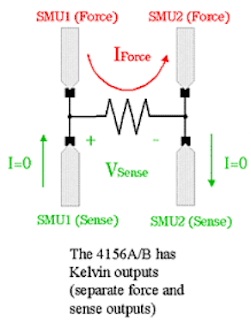Introduction
HP4156A has four High Resolution Source Measure Unit (HRSEM) with resolution of 1fA, 20fA basic accuracy and capability of full Kelvin connection measurement (for measurement on low resistance devices ~50ohm). It also has two Voltage Source Unit (VSU) and two Voltage Measurement Unit (VMU). The specifications for HRSMU are as follows -
* Current Range - 10pA-100mA, Current Resolution - 1fA, Current Accuracy - 20fA
* Voltage Range - 2V-100V, Voltage Resolution - 2uV, Voltage Accuracy - 200uV
Voltage Monitor Unit (VMU) has input impedance of 1Gohm and 1uV differential mode offset function. Lets first understand what is Source Measure Unit
Source Measure Unit
Source measure unit both source and measure at the same time. It could be source voltage and measure current or source current and measure voltage. Below is the schematic diagram of a source measure unit (SMU)
Inside the instrument, there is one voltage source, one current source, one voltmeter and one current meter. Voltage source and ammeter are connected in series and is used for V source mode and current source and voltmeter are connected in parallel and are used for I source mode. One SMU can be used for simple Current-Voltage measurement. Each SMU can also be connected to ground/common.
(I am not sure if ground/common of all the SMU's are internally connected or not, I am guessing they are not connected but when you make connection to 16442A test fixture all the grounds are connected in test fixture and given to common ground)
The SMU's on the 4156A can source V or I in constant mode, linear sweep mode, logarithmic sweep mode or pulsed mode. HP4156A is capable of doing Kelvin measurement which is discussed next.
Kelvin Measurement
Kelvin measurement is required when the device resistance is of the order of cable resistance typically for devices having device resistance of <50ohms .="" account.="" across="" and="" be="" become="" cases="" connecting="" drop="" in="" into="" leads="" nbsp="" p="" should="" significant="" such="" taken="" the="" voltage="">
A Kelvin measurement is a four probe method schematically shown below
Reference
1) http://www.home.agilent.com/upload/cmc_upload/All/What_is_a_Kelvin_measurement.pdf?&cc=US&lc=eng
HP4156A has four High Resolution Source Measure Unit (HRSEM) with resolution of 1fA, 20fA basic accuracy and capability of full Kelvin connection measurement (for measurement on low resistance devices ~50ohm). It also has two Voltage Source Unit (VSU) and two Voltage Measurement Unit (VMU). The specifications for HRSMU are as follows -
* Current Range - 10pA-100mA, Current Resolution - 1fA, Current Accuracy - 20fA
* Voltage Range - 2V-100V, Voltage Resolution - 2uV, Voltage Accuracy - 200uV
Voltage Monitor Unit (VMU) has input impedance of 1Gohm and 1uV differential mode offset function. Lets first understand what is Source Measure Unit
Source Measure Unit
Source measure unit both source and measure at the same time. It could be source voltage and measure current or source current and measure voltage. Below is the schematic diagram of a source measure unit (SMU)
Inside the instrument, there is one voltage source, one current source, one voltmeter and one current meter. Voltage source and ammeter are connected in series and is used for V source mode and current source and voltmeter are connected in parallel and are used for I source mode. One SMU can be used for simple Current-Voltage measurement. Each SMU can also be connected to ground/common.
(I am not sure if ground/common of all the SMU's are internally connected or not, I am guessing they are not connected but when you make connection to 16442A test fixture all the grounds are connected in test fixture and given to common ground)
The SMU's on the 4156A can source V or I in constant mode, linear sweep mode, logarithmic sweep mode or pulsed mode. HP4156A is capable of doing Kelvin measurement which is discussed next.
Kelvin Measurement
Kelvin measurement is required when the device resistance is of the order of cable resistance typically for devices having device resistance of <50ohms .="" account.="" across="" and="" be="" become="" cases="" connecting="" drop="" in="" into="" leads="" nbsp="" p="" should="" significant="" such="" taken="" the="" voltage="">
A Kelvin measurement is a four probe method schematically shown below
As can be seen, in above situation voltage is measured across the device not across device+connecting leads. In case of sourcing voltage, the voltage value is set such that the Vsense is equal to the desired set voltage. An special type of cable called Kelvin cable is required to connect HP 4156A to 16442A test fixture, schematically shown below
The SMU port at the back of instrument has output for both Source and Sense (same in test fixture).
One should also note that each output is a triaxial cable (not BNC). The reason of doing that is to minimize leakage current in the cable dielectric. In a traxial cable center conductor is surounded by circular cable (called guard) which has the same voltage as center conductor thus avoiding any leakage current between center conductor and outermost ground. This is called guarding and used for very high impedance devices or for ultra low current measurement.
If you are not doing ultra low current measurement, you can simply ignore the sense output. In my system, some type I connect HP4156A to probe system. In such cases I ignore the sense and only use Force.
Reference
1) http://www.home.agilent.com/upload/cmc_upload/All/What_is_a_Kelvin_measurement.pdf?&cc=US&lc=eng



